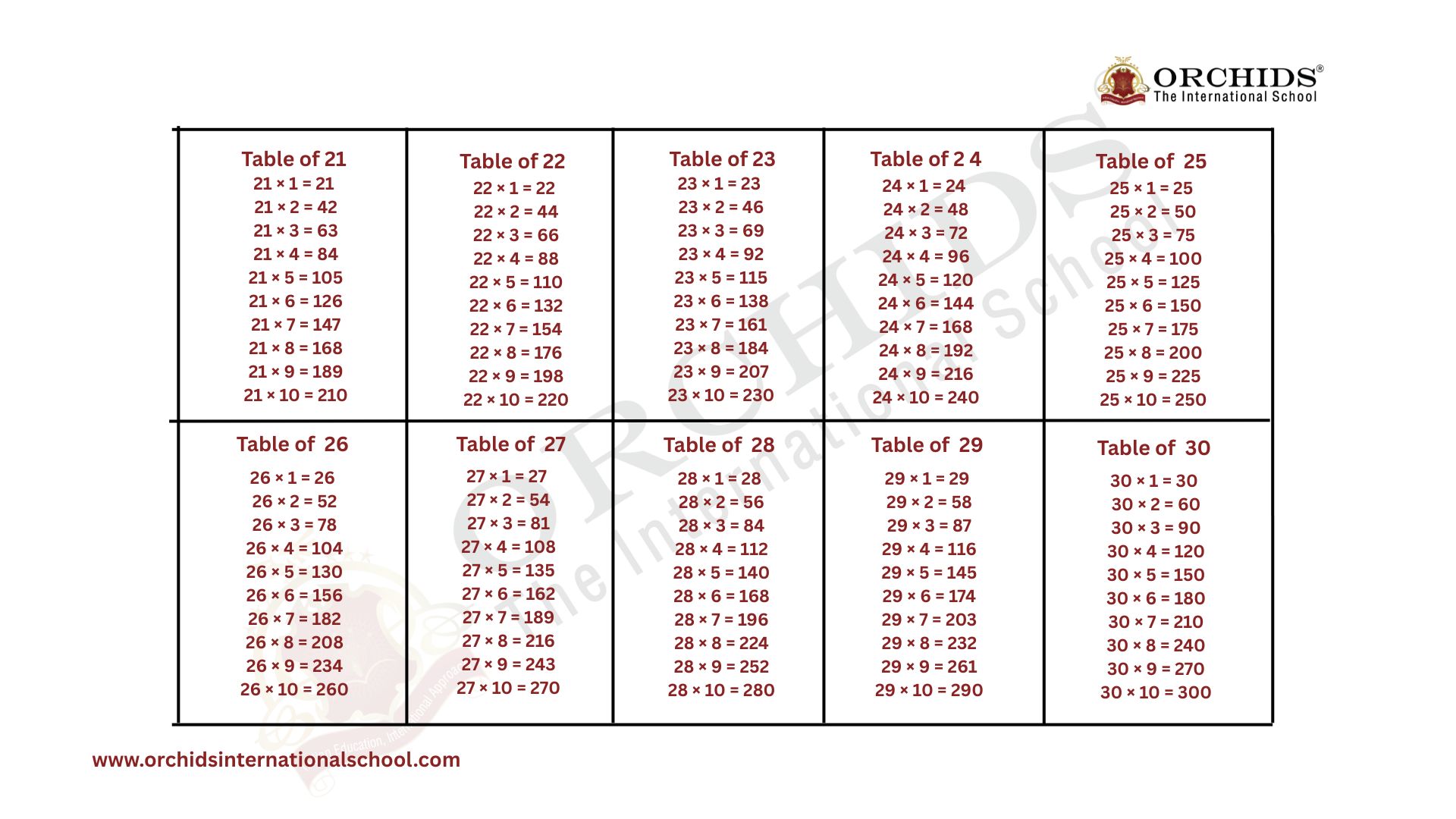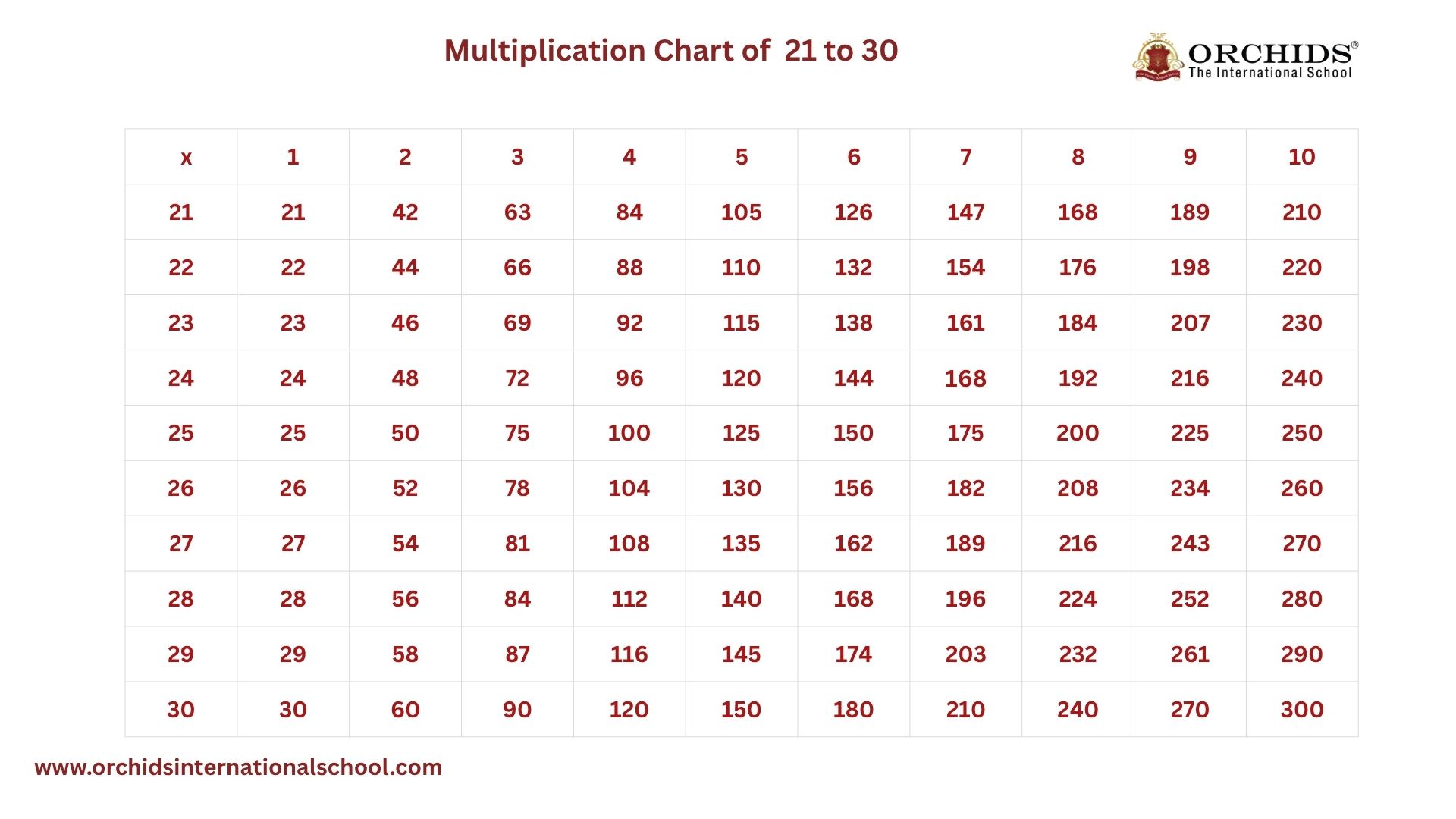Tables of 21 to 30
Multiplication and tables are maybe the most useful of all the tools you’ll learn in mathematics! Multiplication can help you solve problems fast, and using multiplication tables gives you the ability to find answers without needing to add the same number multiple times. It can be so much faster with multiplication.
Let’s look at an example. Let's say you wanted to find out how much 3 groups of 24 make. Sure, you could do it like this:
24 + 24 + 24 =72.
Or you can use the multiplication table and do it like this: 3 × 24 = 72 - using the table of 24.
Here’s how, once you have started working with your multiplication tables from 21 to 30, that will help you:
-
You will quickly and accurately be able to solve bigger math problems
-
You will gain a clearer understanding of division, as it's the opposite of multiplication
-
You will feel more comfortable with larger numbers
-
You will be prepared for harder math topics like percentages, ratios, algebra, and geometry
In each of your tables, you will always notice the way the table gives a number in an incremental manner. For example, the table of 25 gives you:
25, 50, 75, 100, and so on - constantly adding 25 again and again.
If you can quickly and accurately review or practice multiplication facts by simply using your multiplication fact tables from 21 to 30 you will absolutely increase your speed and accuracy when solving math problems at school and in your daily life.
Next, we will review the multiplication fact tables of 21 to 30 in which you will multiply each number 1 - 15 and you will also develop your multiplication and number sense.
Table from 11 to 20

Download the Multiplication Table Chart
Multiplication Table of 21 to 30
| Table of 21 | Table of 22 | Table of 23 | Table of 24 | Table of 25 |
| 21 x 1 = 21 21 x 2 = 42 21 x 3 = 63 21 x 4 = 84 21 x 5 = 105 21 x 6 = 126 21 x 7 = 147 21 x 8 = 168 21 x 9 = 189 21 x 10 = 210 |
22 x 1 = 22 22 x 2 = 44 22 x 3 = 66 22 x 4 = 88 22 x 5 = 110 22 x 6 = 132 22 x 7 = 154 22 x 8 = 176 22 x 9 = 198 22 x 10 = 220 |
23 x 1 = 23 23 x 2 = 46 23 x 3 = 69 23 x 4 = 92 23 x 5 = 115 23 x 6 = 138 23 x 7 = 161 23 x 8 = 184 23 x 9 = 207 23 x 10 = 230 |
24 x 1 = 24 24 x 2 = 48 24 x 3 = 72 24 x 4 = 96 24 x 5 = 120 24 x 6 = 144 24 x 7 = 168 24 x 8 = 192 24 x 9 = 216 24 x 10 = 240 |
25 x 1 = 25 25 x 2 = 50 25 x 3 = 75 25 x 4 = 100 25 x 5 = 125 25 x 6 = 150 25 x 7 = 175 25 x 8 = 200 25 x 9 = 225 25 x 10 = 250 |
| Table of 26 | Table of 27 | Table of 28 | Table of 29 | Table of 30 |
| 26 x 1 = 26 26 x 2 = 52 26 x 3 = 78 26 x 4 = 104 26 x 5 = 130 26 x 6 = 156 26 x 7 = 182 26 x 8 = 208 26 x 9 = 234 26 x 10 = 260 |
27 x 1 = 27 27 x 2 = 54 27 x 3 = 81 27 x 4 = 108 27 x 5 = 135 27 x 6 = 162 27 x 7 = 189 27 x 8 = 216 27 x 9 = 243 27 x 10 = 270 |
28 x 1 = 28 28 x 2 = 56 28 x 3 = 84 28 x 4 = 112 28 x 5 = 140 28 x 6 = 168 28 x 7 = 196 28 x 8 = 224 28 x 9 = 252 28 x 10 = 280 |
29 x 1 = 29 29 x 2 = 58 29 x 3 = 87 29 x 4 = 116 29 x 5 = 145 29 x 6 = 174 29 x 7 = 203 29 x 8 = 232 29 x 9 = 261 29 x 10 = 290 |
30 x 1 = 30 30 x 2 = 60 30 x 3 = 90 30 x 4 = 120 30 x 5 = 150 30 x 6 = 180 30 x 7 = 210 30 x 8 = 240 30 x 9 = 270 30 x 10 = 300 |
Multiplication Chart

Example Questions
1. A toy factory packs 21 toys in one box. If they prepare 7 such boxes, how many toys are packed in total?
Solution: 21 × 7 = 147 toys
2. A classroom has 24 desks. If there are 5 such classrooms in a school, how many desks are there altogether?
Solution: 24 × 5 = 120 desks
3. Ravi saves ₹25 every day. How much money will he save in 10 days?
Solution: 25 × 10 = ₹250
4. A library adds 27 new books each month. How many books will it add in 6 months?
Solution: 27 × 6 = 162 books
5. There are 30 students in one bus. If 9 buses are used for a school trip, how many students are going?
Solution: 30 × 9 = 270 students
Related Links
CBSE Schools In Popular Cities
- CBSE Schools in Bangalore
- CBSE Schools in Mumbai
- CBSE Schools in Pune
- CBSE Schools in Hyderabad
- CBSE Schools in Chennai
- CBSE Schools in Gurgaon
- CBSE Schools in Kolkata
- CBSE Schools in Indore
- CBSE Schools in Sonipat
- CBSE Schools in Delhi
- CBSE Schools in Rohtak
- CBSE Schools in Bhopal
- CBSE Schools in Aurangabad
- CBSE Schools in Jabalpur
- CBSE Schools in Jaipur
- CBSE Schools in Jodhpur
- CBSE Schools in Nagpur
- CBSE Schools in Ahmednagar
- CBSE School In Tumkur











